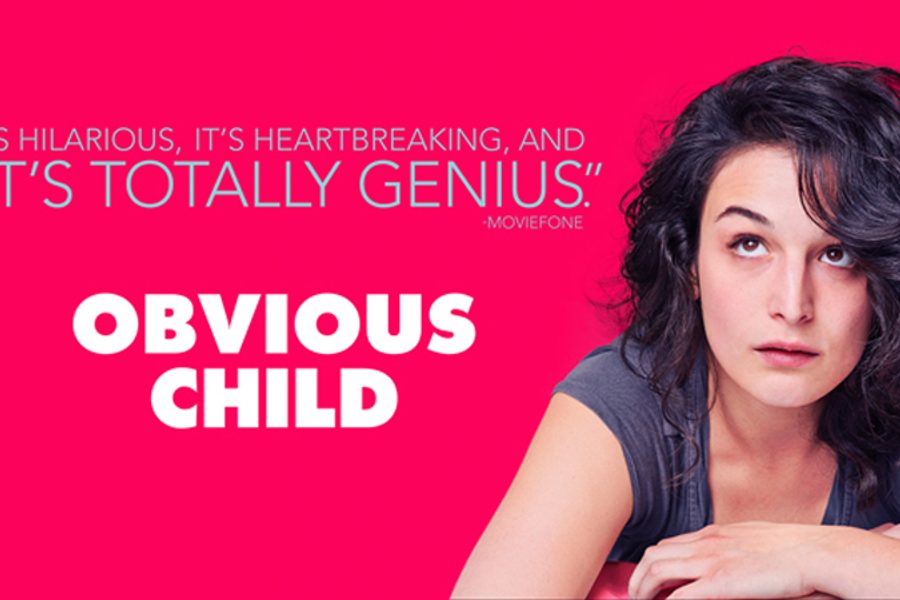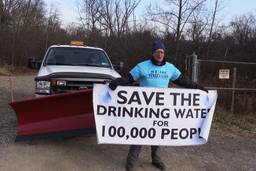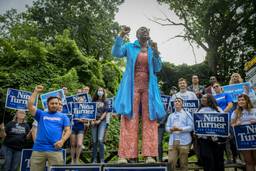Not Your Typical Abortion Story
With ‘Obvious Child,’ filmmaker Gillian Robespierre says she was aiming for honesty and humor rather than ‘an after-school special.’
Molly Bennet

In director Gillian Robespierre’s first feature film, Obvious Child, Jenny Slate plays Donna, a woman drifting toward 30 who spends her nights doing raunchy standup at a grungy club in Brooklyn and makes ends meet by appearing in douche commercials. Newly dumped and increasingly aware that she’s not quite sure what she’s doing with her life, Donna falls into a drunken one-night-stand with a wholesome Vermonter named Max (Jake Lacy), only to learn a few weeks later that she’s pregnant.
If Obvious Child were a typical Hollywood product, this scenario would be the setup for immature Donna and straight-laced Max deciding to make a go of it as a family, with the requisite odd-couple high jinks and heartwarming lessons in responsibility that impending motherhood imparts. Think Knocked Up with the gender roles reversed.
But that’s not what Robespierre, who also wrote the screenplay, is up to. Obvious Child ends not with Donna giving birth, but with her having an abortion. And while Donna and Max do end up together, it’s not because they’re going to be raising a child. For Donna, the film makes clear, this is the best possible ending to the story.
That regret-free abortion is so rarely depicted on screen is what makes Obvious Child genuinely groundbreaking. But Robespierre isn’t given to preaching or politicizing Donna’s situation. Instead, she focuses on exploring the particular predicament of a woman overwhelmed — not just by an unplanned pregnancy, but by adulthood itself, and by the constant reminders that she’s reaching the age when she’s expected to get her shit together.
Robespierre, 35, spoke with In These Times about what it took to get the film into theaters, what’s up next for her, and why she’s come to terms with the “abortion comedy” label.
Obvious Child originated as a short film that came out in 2009. What was the genesis for that idea?
It started with my two friends, Anna Bean and Karen Maine [who co-wrote the short]. We were just a little disenchanted with the representation of young women in their 20s, as well as of unplanned pregnancy. We felt like a lot of the stories in mainstream media about unplanned pregnancy always ended in childbirth. Plus, we didn’t really relate to the women in the romantic comedies that we loved — they didn’t look like us or sound like us. So we sort of smashed these two ideas together: We created a leading lady with all the best lines and the funniest storyline, and developed a scheme of what her safe, regret-free, judgment-free abortion would look and feel like. It’s not a blueprint, by any means, nor is it every woman’s story. It’s just one we felt like our culture in general was silencing — the choice to have an abortion.
In the United States, one woman in three has an abortion at some point in her life, yet there’s hardly any representation of that on the screen. Did you feel any pressure to make it more a universal story, or one that encompasses a variety of different experiences?
I don’t think there’s a way to encompass every woman’s story. The reality is that millions of women will face unplanned pregnancy, and each story and experience is going to be very different. But we did want Donna’s experience to be safe, and we wanted a lot of women in the movie to discuss their own abortions. Donna’s mom [played by Polly Draper] talks about hers, which occurred pre-Roe-v.-Wade, and her friend Nellie [played by Gaby Hoffmann] talks about hers, which she had in high school. We did not want to be a public service announcement. When somebody’s asking about a medical procedure, though, I think there’s a colloquial way for two friends to talk to each other about it — whether it’s, “What does an abortion feel like?” or “As someone who’s had a root canal, can you walk me through getting my tooth pulled?” We wanted to always make sure things were honest and funny and thoughtful, without becoming an after-school special.
And I think that was our main goal — to humanize the choice through humor and through characters who are comfortable with talking about their experience with their parents or friends.
There are a lot of places in the United States where there are protesters outside abortion clinics, where clinics aren’t accessible or where you have to wait 72 hours for the procedure. That is a narrative that I know exists, but Donna is lucky: She has support, emotionally and financially, and she doesn’t get accosted when she walks into the clinic. And I think that’s a reality that just doesn’t get depicted very much in movies, because movies tend to dramatize the harder side of what an abortion can look like.
In trying to get the movie made, did you encounter any difficulties in regard to funding?
Well, we didn’t really go through the studio channel. I don’t think this movie would’ve been made in the studio system. But we were really lucky. My producer, Elisabeth Holm, and I met at a mixer for filmmakers in 2011. I had a very early draft of the feature, and she’d just finished producing a really wonderful movie called Welcome to Pine Hill. At the time, I was looking for a partner, someone who would help really thrust this story out into the world and get financing. It’s the most important relationship a filmmaker could have, really, other than with the audience and the actors.
We worked on the script for about a year and a half, we got to workshop a lot of the standup, and we won a few great grants, like a Rooftop equipment grant, Tribeca All Access grant and an in-kind [equipment] grant from the San Francisco Film Society. And then we raised equity through regular production company channels. We rounded things off with a little Kickstarter campaign, which was for finishing funds — we needed money for color correction and sound design, which is so costly in filmmaking — and we also wanted to let the people who were fans of the short and of Jenny know that we were on our way to Sundance. The last step was finding A24 to distribute the movie, and they were so enthusiastic and passionate about telling Donna’s story and getting it out there — last weekend we were in 155 theaters.
It was a real patchwork way to make a movie, but I would never do it any other way, because we had complete control of the story and the people that we wanted to be in the movie, and we didn’t have to ask permission from anyone.
Do you think the success of the film might inspire other filmmakers to tackle a subject that they were maybe afraid to before?
There are plenty of stories missing in this industry, and I can’t wait to support all the films of the future that have authentic characters whose storylines have been suppressed in our culture. They don’t have to be about unplanned pregnancy; they can be about anything.
When you made the movie, were you conscious of how you might portray Donna in a way that would remove some of the stigma surrounding abortion?
Sure. We were very careful with how we sculpted Donna’s personality and her presence onstage and off-stage. We wanted somebody who was as equally bawdy as she was gentle, and who sometimes had no filter while she was performing — but who was also very thoughtful, good to her friends and close with her parents. She had to be someone who was really relatable by being empathetic, but also extremely funny. And vulnerable, too, at times: somebody who was empowered — I mean, it takes a lot of confidence to go on stage — but also going through a breakup and unemployment and fear of being honest with herself and people around her. Somebody who was finding a place for herself as she lurched toward adulthood.
You filmed at the Planned Parenthood in New Rochelle, New York. What was the process of getting permission to film there? Were they at all involved in advising on the scenes that were actually taking place at the clinic?
They were. We sent them a draft of the script as we were heading into early stages of preproduction. We really wanted to partner up with Planned Parenthood, for multiple reasons. For one thing, we wanted to shoot it in Planned Parenthood; the short took place in my mom’s foot doctor’s office, and while we were okay with going back there, I really didn’t want to. That’s one thing I said to my producer. I said, “Please don’t let us go back to the foot doctor!” She said, “Don’t worry, I won’t.”
She got in touch with Planned Parenthood representatives and sent them the script, and there was a lot of great back-and-forth. We also really wanted to be accurate about the procedure, and they were really excited about the movie and how we were telling it. They never wanted anything about the story to change; they just made sure that the scenes with the doctor were as realistic as possible and that the dialogue was correct. And now they’ve been a really great partner in getting the word out to people all over the country. It has such a strong reach — I’m a member of Planned Parenthood, so I’m on its mailing list, and it’s really cool when I get an email talking about the movie.
The movie’s been getting great reviews, but have there been any comments that annoyed you or seemed off-base?
For a while, I felt like journalists were being lazy with their description of the movie every time they used “abortion comedy” in their headlines. Because it’s not an abortion comedy. Those two words don’t go together for us, and they make the movie a lot smaller than it is. But then I was like, “Wait a second, this is actually awesome.” Because the articles are very positive in the way they talk about Donna’s experience with the procedure. So I’m not complaining, because I think “abortion comedy” takes the heaviness and the stigma away from the word in a really positive way.
Have you had any response from viewers that really particularly moved you?
Yeah, at a screening in Baltimore, a woman came up to me and said that she had an abortion in the ’60s, and it didn’t have a happy ending like Donna’s story, and our movie changed her narrative and changed how she viewed her own experience. That was pretty great. And then some people just come up to me and just say cute things like, “Do you have a video camera in my apartment?” and “I dance around to Paul Simon in my underwear.” So there are things like that, too.
What’s your next project?
I am writing a movie about divorce. Right now, it’s called “Untitled Divorce Comedy.” Elisabeth Holm and I are writing it together, and we’re really excited to delve into divorce, and we’re definitely writing a role for Jenny. She’s a wonderful actress, friend, collaborator and muse, and I can’t wait to keep making movies with her until I’m 100.

I hope you found this article important. Before you leave, I want to ask you to consider supporting our work with a donation. In These Times needs readers like you to help sustain our mission. We don’t depend on—or want—corporate advertising or deep-pocketed billionaires to fund our journalism. We’re supported by you, the reader, so we can focus on covering the issues that matter most to the progressive movement without fear or compromise.
Our work isn’t hidden behind a paywall because of people like you who support our journalism. We want to keep it that way. If you value the work we do and the movements we cover, please consider donating to In These Times.






